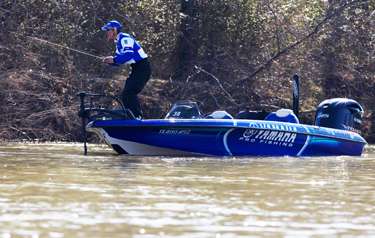
He may be the quiet type, but Elite Series pro Takahiro Omori can get downright cranky — when he’s hunting bass, that is. The source of his “crankiness”? The 2004 Bassmaster Classic winner is sold on the potential of shallow running crankbaits.
Particularly during spring and fall, when a lot of water in his preferred zone of 1 to 6 feet remains off colored and thick with shad, Omori appreciates the time-management benefits of shallow cranking. “I can cover a lot of water quickly, and I get quality bites and quality fish.”
Naturally, this game diminishes on a deep canyon lake with high clarity, but with water temperatures in the 60-degree range, Omori feels supremely confident taking his shallow cranks into the back of a creek, looking for stumps, laydowns or docks and doing his best to irritate the locals.
“You can make the fish react even if you see a fish is not feeding,” Omori said. “If you hit an object with the crankbait, that wobble can trigger the fish to bite. When the main lake bite is not going, you can go back in a creek and — if you can find the bait — you’re going to have a good day.”
The wobble is the key, so Omori likes a bait that knows how to shake its badonkadonk. Topping his list is the Bagley Balsa B, a good choice for fishing around stumps and laydowns because the bait’s buoyancy helps him avoid hang-ups.
Omori also throws a Lucky Craft Fat CB BDS (Big Daddy Strike) crankbait. This one he’ll use around vegetation such as milfoil or lily pads. He’ll mostly fish the outside edges, but he’s not averse to running through the garden.
“Anytime you cut the [vegetation] that can trigger a strike, so don’t hesitate to throw in there and expect to get hit right away,” Omori said. “You have to practice so you don’t get hung up every time. You have to feel what your bait is doing — is it hitting bottom, hitting a stump or getting hung up?
“Most times, if you’re wobbling stops, you’re either hung up or a fish has got your bait, so you have to pay attention to what your bait is doing all the time.”
The right outfit advances that objective. Omori chooses a 7-foot Daiwa cranking rod and a Daiwa 7:1 baitcaster carrying 14-, 16- or 20-pound Sunline fluorocarbon line. He’s also strict about sharp hooks, so he fits all of his crankbaits with red Gamakatsu round-bend trebles in size 2, 3 or 4. Tempered high-carbon steel makes a solid connection, but the needlepoint sharpness is what Omori demands.
“A sharp treble hook is very important,” he said. “Sometimes I’ll change my hooks five or six times a day, especially when I’m fishing around riprap or rocks. You have to keep all three points sharp at all times.”
Angler sharpness also matters here. Power fishing wears on the body and mind, but Omori has trained himself to not only endure the grind but actually revel in the challenge. On the physical side, he avoids overtaxing his joints by using more sidearm casts — less wearing than overhead heaves. Also, he avoids any junk food or carbonated drinks. Omori’s nourishment: one homemade rice ball (white rice and seaweed) at takeoff, another at midday and lots of water.
On the mental side, he keeps himself on track by focusing on the visual advantage. “I enjoy shallow cranking because when you can see an object that you are casting to, it’s more fun — unlike fishing in deep water where you can’t see what you’re fishing and you have to imagine where the fish might be.”
His advice for would-be shallow crankers — keep casting. “Sometimes I’ll throw at the same object 10 times to get a bite. I just keep changing angles and making my bait bump the object.
“Sometimes in the morning the shallow fishing isn’t active, but in the afternoon, when the shad come up, the shallow fish get more active. So if you think you’re in a good area, just stick with it and you might catch a big fish later in the day.”





